| PACHAMAMA Research by Manuela Caregnato for www.ilcerchiodellaluna.it Translation by Katiuscia Cancedda translatethis1@yahoo.co.uk |
Versione italiana |

Pachamama or Mama Pacha, is the Earth Goddess of South America’s Andean population, still honoured by people who even nowadays recognise themselves in the Inca’s culture.
Literally Pacha Mama means “mother space time” or "mother universe" in Quechua language, all one with Mother Earth. Mountains’ tops are her breasts, rivers are her milk of life and fields are her fertile womb.
Pachamama is therefore the generous Goddess of fertility and agriculture, nutritional mother that gives life, but who can also show her cuel side when producing earthquakes to remind her children that they must always honour her.
Pachamama takes us to a type of spirituality of the immanent earth, pantheistic (from Greek pan: “all”) where all is sacred and divine, the earth is sacred and so are its living beings, in contrast with the transcendent spirituality dominating patriarchal cultures. Pacha Mama is the Mother Earth of a religion that cannot be defined as matriarchal in itself, since its priests are male; however there is an attitude to deal with the earth in a less aggressive way, more respectfully, surely more sacredly than other populations with patriarchal religions often accompanied by a certain degree of rationalism and utilitarianism that places the respect for our environment and our animals among lower values. This attitude is also present amongst other populations practising a type of immanent rather than trascendent religiousity.
Among these so called “underdeveloped” populations, in addition to a greater respect for the earth, a role of superior social primacy is also found, which is allocated to the elderly, as well as an attitude of better attention towards women, children and all socially weaker groups.
THE MYTH
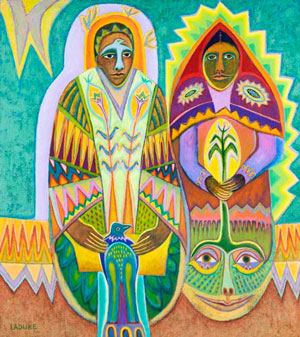
Pachamama had a spouse (who was also her brother), Pachakamac, from whose union two twins were born, a male and a female.
As in other Andean myths, their father died or, according to other legends, he disappeared at sea and remained captive in a coastal isle, victim of a spell.
Pachamama remained widow and alone with her children. Darkness reigned upon the Earth.
They noticed a light in the distance, which they followed by climbing mountains, crossing lagoons and fighting against monsters.
Finally, they came to an unknown cave like Waconpahuin, where a man called Wakon lived. He had a potato and a stone pan on the fire and asked Pachamama’s two children to go and get some water. Since they were delayed, Wakon tried to seduce Pachamama, but she refused so he killed her, divoured her body and put the remains inside the pan.
When the twins came back, they asked about their mother. Wakon didn’t tell them anything and told them that she was to return any time, but the days went by and their mother wouldn’t return.
Huaychau, dawn-announcing bird, felt compassionate toward the twins and told them the truth on their mother, alerting them of the danger of being with Wakon. The children then fastened Wakon’s hair to a huge stone while he slept and escaped quickly.
They met a wolf, Añas, who hid them in her hole after asking them the reason for their escape. Meanwhile, Wakon freed himself and started looking for the twins. He met various animals to which he asked if they’d seen the two children, but no one could help him.
Finally, he met Añas who told him that the children were on top of a mountain and that he would have been able to imitate their mother’s voice once reached the top so that the children could come out.
Wakon ran frantically toward the top without realising the trap that the crafty fox Añas had set him. Wakon fell into a ravine causing a violent earthquake while dying.
The twins stayed with Añas who nourished them with her blood. Nauseated, they asked if they could go picking potatoes and found a “goose” (Oxalis Tuberosa, a potato-like tuber) resembling a doll, with which they played until a piece came off. So the children stopped playing and fell asleep.
In her sleep, the girl dreamed of throwing her hat in the air that remained suspended without falling. The same thing happened with her clothes. Once awakened, she told her dream to her brother and, while the children questioned the meaning of the dream, they saw a very long rope in the sky, and, intrigued, climbed up. At the end of the rope they saw their father, Pachakamac, feeling sorry for their misadventures. Once reunited to their father, they were transformed into the sun and moon.
As far as Pachamama is concerned, she remained down, taking the form of a massive snowfield still called today La Viuda (The Widow).
THE INCA'S PANTHEON
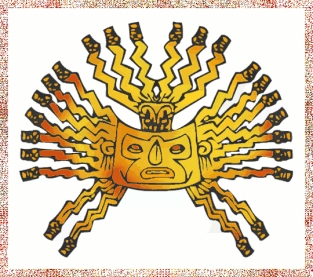
In the Incas' conception, the world is subdivided in three levels: Hanan Pacha, the world of above where divinities reside; Kay Pacha, this world; Uku Pacha or Urin Pacha, the world of below, where the spirit of the dead and unborn children reside.
This is the way in which the Incas converged with the idea of space and time.
In their culture, the link with stars, nature and all its element was deeply felt, and their deities came to life in them.
The people’s religion
In the Incas' dualistic vision, Inti was the high masculine divinity, with a low feminine counterpart, Pachamama.
Inti’s cult was actually reserved to a restricted èlite, while Pachamama’s cult was more connected to the rural world, thus to the population and the majority of the Andeans, who fed for her a deeply mutual relationship of devotion. Daily rituals were celebrated in her honour in order to guarantee that a sufficient quantity of food was available. During sowing and harvest, women working on fields used to whisper to Mamapacha, pouring, every now and then, on her surface food made out of wheat , as offerings of gratitude.
The èlite’s religion
Wiraqucha was the supreme divinity creator of the Sun, the Moon and the Stars, the God that had formed the first men from clay.
Despite the power assigned to this God, he was always represented as a small child aged approximately 8 to 10 years.
Wiraqucha had a son named Inti.
Wiraqucha also had a daughter, Mama Quilla, sister and wife of Inti, who generated Mama Ocllo and gave birth to the first Inca.
Inti had a son named Pachakamaq (meaning “creator of the Universe” in Quechua language, pacha=earth; kamaq= creator), who was the God of the sky or God of the moon, who presided to the growth of humans, cereals and birds.
The image of Pachakamac was so similar to that of man that the Incas felt it was not important to erect statues or to dedicate impressive temples in his honour, but to dedicate human sacrifices to him.
Pachakamac had a wife, Pachamama, Goddess of the Earth.
There are other myths on Wiraqucha, among which:
-He generated the sky and the earth first, then men. Due to unspecified sins of the latter, he transformed them in stone statues.
-He emerged from the Titicaca lake and created a Tiahuanaco, the sky, the sun, the stars and men. Then he carved men from stones and allocated them in the lands.
-Wiraqucha is said to have had a very bad son named Taguapica who used to do the opposite his dad did. If Wiraqucha created good men, Taguapica made them bad; if his father made plains, he’d transform them into mountains and viceversa. He’d dried up sources of water created by his father. After many similar vicissitudes, Wiraqucha came to the sea, cast his cloak and disappeared in the waves.
Other minor gods of this complex pantheon are Apu (God of mountains), Apocatequil (God of lightening), Catequil (God of thunder), Cavillaca (fruit-eating virgin Goddess, from whom Coniraya, Goddess of moon, was born ), Chasca (Goddess of dawn, of dask and of the planet Venus, protector of virgins), Chasca Coyllur (Goddess of flowers), Mama Coca (Goddess of health and joy), Coniraya (lunar divinity ), Ekkeko (God of heart and good health), Kon (God of rain and wind coming fron South), Mama Allpa (Goddess of fertility), Mama Cocha ("mother Sea"), Mama Quilla ("mother Moon"), Mama Zara (Goddess of wheat), Pariacaca (God of water, born from pre-Inca mithology), Supay (God of death), Urcaguary (God of metals), Apu Illapu (God of rain and thunderstorms).
Very much worshipped by the population were the huaca (forces) of mountains, lakes, rivers and trees, to whom the Incas consecrated piles of stones and offered sacrifices of children.
Religious structure
The Inca religion was evidently the reflection of the state structure, with the God Inti being the image of the emperor, or Sapa-Inca (Head of the Inca).
Whenever the Incas conquered a land, they would build a temple to honour Inti. The most important temple in Cuzco was the Coricancha, dedicated to the Sun.
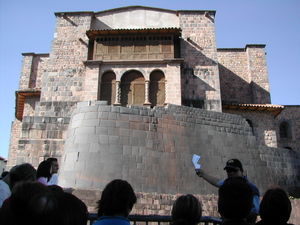
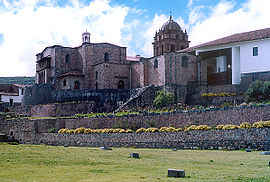
During the kingdom of Pachacuti (ninth emperor of Cuzco’s empire, between 1438 and 1471-1472, whose name means “him who reforms the world” in Quechua language, so much so that he began an era of conquering that saw Cuzco expand its dominion from the valley to most of South America), the cult of Viracocha expanded as well, also transforming him from creator to civilizing hero in various myths.
The imperial caste and the clergy dedicated their cult to Wiraqucha, while people’s religion was devoted to natural forces and to earth.
Inti, powerful God of the Sun, was celebrated twice a year with impressive ceremonies, in occasion of Raymi (the Sun dance) during which a fire was lit up through the use of a burning glass, and such fire was secured solely by the Virgins of the Sun (Taita Inti). The celebration used to last eight consecutive days and is still celebrated nowadays by Andean populations.
Another important god after Inti and Wiraqucha was Inti Illapa, The Thunder. He travelled in the sky with a flash of lightning and a bat in order to generate thunderbolts. He would draw from the Milky Way the water to be poured on earth.
Unlike one could think, during the times of devotion and celebration of their many divinities, the Incas used to practise human sacrifices only rarely, opting instead for animal sacrifice. The employment of human sacrifice was dedicated to times in which catastrofies and state crisis occurred, and the choice of the child to sacrifice took place everywhere within the territory. The child had to be handsome with no physical defects of any kind; he was accompanied in the presence of the emperor and thus taken to a mountain where the sacrifice took place by a shot to the skull. These sacrifices are confirmed by the discovery of a little mummy.
The Year of the Incas
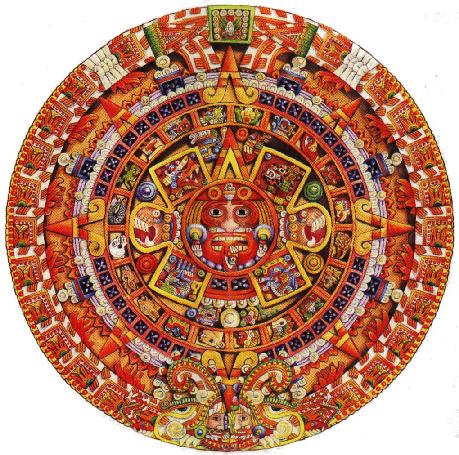
The year of the Incas consisted of 12 months of 30 days, starting from December with the important festival of Capac Raymi, followed by a monthly festival. Cerimonies were often long and very complex, and were more often associated to issues relating to human health as well as crops and agricultural products. Perhaps the most important figure of male priest was for the Inca Willaq Uma who had the power to appoint new priests and to teach them the religious doctrine; besides this, they also acted as healers and magicians who devoted themselves to divination on behalf of others. Women also had an opportunity to become Mamaconas, a privilege reserved to noble and very beautiful girls who could learn the secrets of this art after years of study and work, and swear an oath of chastity to serve the God Inti (the Virgins of the God Sun); otherwise they could prepare themselves to become wives of noble ranks. Unfortunately, despite numerous researches and studies around this population and its culture, the secret and the halo of mystery accompanying the Incas for centuries could not been unveiled in its depths. From what's left as proof of this civilization, the monumental remains of temples like the fortresses of Sacsayhuaman, near Cuzco, and the towns of Machu Picchu and Ollantaytambo represent the most popular examples together with the enormous terraces built for cultivation, bearing in mind that these colossal structures were built without using mortar that would have sealed the massive boulders employed for their construction, enough to consider that the Incas were the depositaries of more than 3000 years of Andean cultural and technological development.
In the medical field, the Incas used to perform cranial drillings and practised cranial bone remodelling in very young children, so that the shape of their heads would become conic. Their kingdom internal hierarchy structure, based on their conception of dual, had two Inca rulers: an Inca hanan above and an Inca hurin below. Their expansionistic projects still arouse today some perplexities: there is evidence of direct expeditions to Polinesia, especially during the period of king Pachacutec who conquered the kingdom of Chimu and other areas of the Ecuador Sierra with his son Tupac Inca Yupanki. After him, Tupac Inca Yupanki extended his achievements to the central-meridional shore of Peru, the Southern Bolivian plateau, the Northwest Argentinian plateau, the Northern and the centre of Chile and next the Ecuador, where he founded the secondary capital of Quito. The instruments used daily by the Incas to write were called Quipus, a system of knotted threads still not understood and therefore failing to reveal the method by which it was employed.
RITE FOR PACHA MAMA
Every loving gesture of respect toward Mother Earth is a rite cherished by Pachamama.
It is appropriate to chant or sing while carrying out agricultural tasks, or make offerings in the form of wheat or rice or crystals to be buried at the foot of a treasured tree, as a token of gratitude.
Or one could adopt a small woodland to care for it, or a beach, or again organise a meeting between friends to clear off garbage from a place of nature, teaching children to do the same.
Any act of love is appreciated by Pachamama.
PRAYER TO PACHA MAMA
"Earth, divine Goddess, Mother Nature, who generates everything and always makes the sun given to people reappear; guardian of the sky, of the sea and of all Gods and powers; by thy influence all nature quietens and sinks in to sleep. And again when it is convenient to thee, thou send the pleasant light of day ahead and give nourishment to life with thy eternal promise; and when the spirit of man passes away, it returns to thee. Indeed, to good right, thou are called Great Mother of Gods; Victoria is thy divine name.
Thou are mighty, Queen of Gods! Oh Goddess, I adore thee as divine, I call upon thy name: condescend to grant me what I ask of thee, so that I may fill thy divinity with grace in exchange, with the faith thou deserve.."
English herbarium of the XII century, British Museum.
______________________________________________________